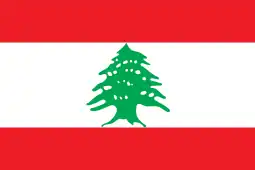 | |
| Use | National flag and ensign |
|---|---|
| Proportion | 2:3 |
| Adopted | 7 December 1943 |
| Design | A horizontal triband of red, white (double height) and red; charged with a green Lebanese cedar tree. |
| Designed by | Henri Philippe Pharaoun |
.png.webp)
The national flag of Lebanon (Arabic: علم لبنان) is formed of two horizontal red stripes enveloping a horizontal white stripe. The white stripe is twice the height (width) of the red ones (ratio 1:2:1)—a Spanish fess. The green cedar (Lebanon cedar) in the middle touches each of the red stripes and its width is one third of the width of the flag.[1]
Symbolism

The presence and position of the Cedar in the middle of the flag is directly inspired by the Lebanese cedar (Cedrus libani). The Cedar is the symbol of Lebanon. The Cedar of Lebanon has its origin in many biblical references.
The cedar of Lebanon is mentioned seventy-seven times in the Bible, notably in the book Psalms, chapter 92, verse 12, where it says that "The righteous shall flourish like the palm tree, He shall grow like a cedar in Lebanon"[2] and Chapter 104, verse 16, where it is stated: "[t]he trees of the Lord are well watered, the cedars of Lebanon that he planted".[3]
Alphonse de Lamartine (1790–1869), marveling at the cedars of Lebanon during his trip to the Middle East with his daughter Julia, had these words: "[t]he cedars of Lebanon are the relics of centuries and nature, the most famous natural landmarks in the universe. They know the history of the earth, better than the story itself".[4]
Antoine de Saint-Exupéry (1900–1944), who loved the cedars and also had visited Lebanon in 1935, wrote in his work Citadel "[t]he peace is a long growing tree. We need, as the cedar, to rock its unity".[5]
In 1920, in a text of the proclamation of the State of Greater Lebanon, it was said: "[a]n evergreen cedar is like a young nation despite a cruel past. Although oppressed, never conquered, the cedar is its rallying. By the union, it will break all attacks".[5]
The white color on the flag represents the snow as a symbol of purity and peace. The two red stripes refer to the Lebanese blood shed to preserve the country against the successive invaders.
Construction sheet
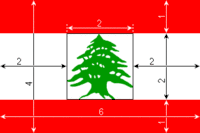
According to the Article 5 of the constitution of Lebanon: "The Lebanese flag shall be composed of three horizontal stripes, a white stripe between two red ones. The width of the white stripe shall be equal to that of both red stripes. In the center of and occupying one-third of the white stripe is a green cedar tree with its top touching the upper red strip and its base touching the lower red stripe".[6]
Colors scheme
Colors scheme |
Red | White | Green |
|---|---|---|---|
| RAL | 3028 | 9016 | 6024 |
| CMYK | 0-91-87-7 | 0-0-0-0 | 100-0-52-35 |
| HEX | #EE161F | #FFFFFF | #00A850 |
| RGB | 238-22-31 | 255-255-255 | 0-167-80 |
History
Flag of the Lamaite princes
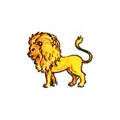 Feudal Flag of the Lamaite princes during Middle Ages
Feudal Flag of the Lamaite princes during Middle Ages
Flag of Maanid emirate
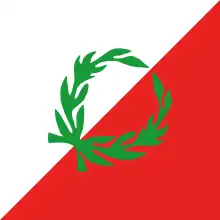 Flag of the Maanid Emirate (1119–1697)
Flag of the Maanid Emirate (1119–1697)
French Mandate of Lebanon
.svg.png.webp)
 Flag of the State of Greater Lebanon during the French mandate (1920–1943)
Flag of the State of Greater Lebanon during the French mandate (1920–1943)_2.svg.png.webp)
 Flag of the State of Greater Lebanon during the French mandate 1920–1943 (variant)
Flag of the State of Greater Lebanon during the French mandate 1920–1943 (variant)_3.svg.png.webp)
During the French Mandate of Lebanon, the Lebanese flag was designed by the president of the Lebanese Renaissance Movement, the late Naoum Mokarzel. It was similar to the tricolour flag of France but with a green cedar (Lebanon Cedar) in the middle.
Lebanese Republic

The present Lebanese flag was adopted just prior to independence from France in 1943. Seeking independence, the actual flag was first drawn by member of parliament Henri Pharaon[7][8] in the Chamber of Deputies Saeb Salam's house in Mousaitbeh by the deputies of the Lebanese parliament. It was adopted on 7 December 1943, during a meeting in the parliament, where article 5 in the Lebanese constitution was modified.
One theory is that Henri Pharaon based the composition of the flag on the Lebanese geography and therefore, the first red represents the Mount Lebanon and the second red represents the Anti-Lebanon Mountains and the white represents the Beqaa Valley, which is situated in the middle of the two mountain ranges on the map of Lebanon. And the green cedar (Lebanon Cedar) in the middle of the white part touches each of the red stripes is added because Lebanon is sometimes metonymically referred to as the Land of the Cedars.[9][10] The composition of the white stripe (a Spanish fess) could have been inspired by the red-yellow-red Flag of Spain, where the flag structure is based on the Lebanese connection to the Mediterranean Sea and its Phoenician past that reached to the Mediterranean shores of present-day Spain.
However, the most likely inspiration for the modern flag is the flag of the precursor to the modern republic, The Mount Lebanon Emirate. The Emirate bore the flag of the Ma'an dynasty, a Druze dynasty which included one of the most influential figures in the shaping of an independent Lebanese identity, Emir Fakhr al-Din II,[11] who struggled through his reign to establish independence from the Ottoman Empire. The flag has the exact same color scheme and even a similar composition. Red, white, and green being the primary colors with the green wreath in the center being replaced by the cedar in the modern flag; it is entirely probable that the modern flag is simply a redesign of this older, dynastic flag. Further evidence is supported by the fact that many government institutions in Lebanon continue to use the Ma'anid flag, such as the flag of the Lebanese Armed Forces, but without the green wreath, and it is still in place to this day.
Variant flags of Lebanon
The following is a list of variant flags used in Lebanon
 Design stored at WIPO
Design stored at WIPO.svg.png.webp) Design commonly seen from 1943-1995
Design commonly seen from 1943-1995 Flag as drawn and approved by the members of the parliament during the Declaration of independence in 1943
Flag as drawn and approved by the members of the parliament during the Declaration of independence in 1943 Flag of the Arab Revolt flown above the Grand Serail of Beirut for nine days before being taken down on 10 October, 1918[12]
Flag of the Arab Revolt flown above the Grand Serail of Beirut for nine days before being taken down on 10 October, 1918[12] Flag used in Deir El Qamar, Capital of the Maanid and early Chehab emirs (1830)
Flag used in Deir El Qamar, Capital of the Maanid and early Chehab emirs (1830) Rebels Flag during the Marada era
Rebels Flag during the Marada era National Maanid flag
National Maanid flag Rebels' flag during the rule of Prince Ibrahim[13]
Rebels' flag during the rule of Prince Ibrahim[13]
Official Lebanese flags from 1918–present
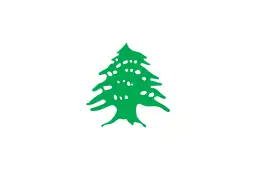
.svg.png.webp)
 Flag of the State of Greater Lebanon during the French mandate (1920–1943)
Flag of the State of Greater Lebanon during the French mandate (1920–1943)
 Flag of the Republic of Lebanon (1943–present)
Flag of the Republic of Lebanon (1943–present)
Flags of municipalities in Lebanon
Other flags
 Flag of the Lebanese Army
Flag of the Lebanese Army Flag of the Lebanese Air Force
Flag of the Lebanese Air Force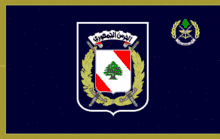 Flag of the Republican Guard
Flag of the Republican Guard
 Flag of the County of Tripoli, 1102-1289 AD
Flag of the County of Tripoli, 1102-1289 AD Flag of the Lebanese Troops during WW1
Flag of the Lebanese Troops during WW1
See also
Notes
- ↑ The description of the flag is cited in the Lebanese Constitution, Chapter 1, Article 5.
- ↑ "The Bible". Retrieved 27 October 2014.
- ↑ "The Bible". Retrieved 27 October 2014.
- ↑ "Firdaous – Arab world". 28 November 2007. Retrieved 2 September 2013.
- 1 2 "L'Orient-Le Jour". 16 July 2014. Retrieved 27 October 2014.
- ↑ "Ministry of information". Archived from the original on 2 November 2014. Retrieved 27 October 2014.
- ↑ "Henry Pharoun Is Slain at Home; Founder of Free Lebanon Was 92". The New York Times. 7 August 1993. Retrieved 8 October 2008.
- ↑ "Lubnān, Republic of Lebanon, Al-Jumhūriyyah al-Lubnāniyyah". Flags of The World. CRW. Retrieved 8 August 2009.
- ↑ Budge, E.A.W. (2010). The Literature of the Ancient Egyptians. HardPress. p. 261.
- ↑ Cromer, G. (2004). A war of words: political violence and public debate in Israel. Cass series on political violence. Frank Cass. ISBN 978-0-7146-5631-1.
- ↑ "History Atlas". www.historyatlas.com. Retrieved 19 August 2020.
- ↑ ابي ياغي, جان دارك (December 2016). "أعلام ورايات رفعت في أراضينا منذ القدم". lebarmy.gov.lb. Lebanese Army. Archived from the original on 22 June 2021.
على أثر انتهاء الحرب العالمية الأولى ودخول الحلفاء إلى سوريا ولبنان، رُفع العلم العربي المربَّع الألوان فوق دار الحكومة في بيروت لمدة تسعة أيام فقط، إلى أن أنزله الحلفاء في تاريخ 10 تشرين الأول 1918.
- ↑ "Historical Flags (Lebanon)".
External links
- Lebanon at Flags of the World
- Lebanese Flag Accurate, high quality, & high resolution flags of Lebanon.

